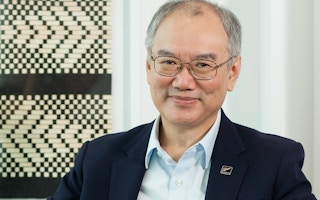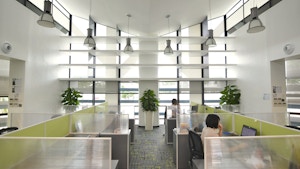When the Singapore Green Building Council (SGBC) was formed in 2009, two of its key tasks were to connect with the international green building community and to create a sustainability certification scheme for products used in construction.
These were the tasks that engineering-trained Lee Chuan Seng found himself facing when he landed in the hot seat as the founding president of SGBC, he recalls.
The Building and Construction Authority (BCA), which comes under the Ministry of National Development, had taken the lead to promote sustainability in the built environment by introducing the Green Mark rating scheme just four years before and had made the green building certification scheme mandatory for buildings with more than 2,000 square metres of floor area.
But even though BCA had successfully championed the green building cause in Singapore, its status as a government body presented an obstacle when it came to engaging with the World Green Building Council (WorldGBC), the global organisation advocating green buildings.
“Being a government agency, they faced some constraints in working with international non-government organisations (NGOs),” Lee explains. Like many of the groups driving the adoption of green buildings in other countries, the WorldGBC is an NGO. “Hence, one of SGBC’s main thrusts was to be the liaison in that space,” he says.
Lee was in the thick of the action at that time: he was the chairman of engineering consultancy Beca Asia, board member at BCA, chairman of the BCA Green Mark Advisory Committee, and co-chair of the BCA’s International Panel of Experts that first mooted the idea of a green building council for Singapore.
Wooing WorldGBC
SGBC started by offering support to WorldGBC in setting up its representation system to better engage Asian countries, even organising the WorldGBC International Congress in Singapore in 2010. At the time, he recalls, the WorldGBC board was heavily Westernised and faced difficulties in reaching out to this part of the world.
The success of SGBC’s efforts led to the council becoming a full member of WorldGBC in less than 12 months—a process that usually takes two to three years. Lee joined the WorldGBC board that same year.
When Tai Lee Siang took over as SGBC president in 2011, he also joined the WorldGBC Board the year after. Since 2010, there has always been a Singaporean on the WorldGBC board, and Tai also went on to chair the WorldGBC from 2016 to 2018.
SGBC’s other main thrust was to develop and implement a system for certifying the sustainability of products used in the building and construction industry, such as window and wall materials, chillers and other equipment, and even interior fittings.
“Our engagement in the international space, especially with other green building councils around the region, could help to get the certification recognised,” Lee explains.
“The initial setup was massive because of the sheer number of products, equipment and material to deal with. But the industry involvement was great. We had more than 100 people from all over the industry volunteering their time and expertise to identify and evaluate items for inclusion in the scheme,” he recalls.
That huge collaborative effort eventually took the shape of the Singapore Green Building Product Certification Scheme, which was also rolled out in 2010.
That same year, the Singapore government awarded Lee the Public Service Medal for services to the engineering profession.
Making sustainability mainstream
One of SGBC’s greatest achievements over the years has been to get built environment practitioners—developers, architects, engineers, contractors, and suppliers—to recognise the value and benefits of green buildings, so much so that the concept is now mainstream in the construction sector, remarks Lee, who retired from Beca Asia a couple of years after his term at SGBC’s helm ended.
Another big score is in boosting Singapore’s reputation in green buildings. “SGBC and BCA have received queries and requests for assistance to help with green buildings or even to set up national frameworks for green buildings [from all across the globe],” he says.
“
The ability to do more with less is so important these days, because we are facing increasing demands on decreasing resources.
Lee Chuan Seng, founding president, Singapore Green Building Council
That reputation, in his experience, has helped companies secure projects even in the highly competitive international arena. “In some countries, clients tell us they have the best engineers in the world, from America and Europe, lining up outside their door to serve them. So what do we, coming from a small place like Singapore, have to show? But when we are able to tell them that we have designed and completed green buildings that can save millions of dollars per year, they take note and we are able to secure work with them.”
Now, with digitisation and data analytics playing an increasing part in sustainability, he predicts that the design and construction of green buildings will improve at a greatly accelerated pace, with SGBC at the heart of this transformation.
“SGBC is well placed to lead the charge in these efforts,” he says, pointing to the initial reason for its formation. “As an NGO we are able to engage more deeply with our stakeholders to improve these and broaden as well as deepen the skillsets that they can acquire.”
Lee now advises the Ministry of National Development on science and technology issues, chairs the Technical Advisory Work Group for the National Research Foundation’s Urban Solutions and Sustainability programme, and this April was appointed chairman of the National Environment Agency.
Sustainability, he believes, comes naturally to engineers due to the nature of their work, and this is why green buildings—and SGBC’s work—have caught on so fast within the industry.
”[As an engineer,] you are very focused on creating good, practical solutions that are cost-efficient,” he explains. “It’s very aligned with sustainability: a lot of consideration given to how best to minimise waste, minimise the consumption of resources, and still balance quality with limiting factors.”
He concludes: “The ability to do more with less is so important these days, because we are facing increasing demands on decreasing resources.”













